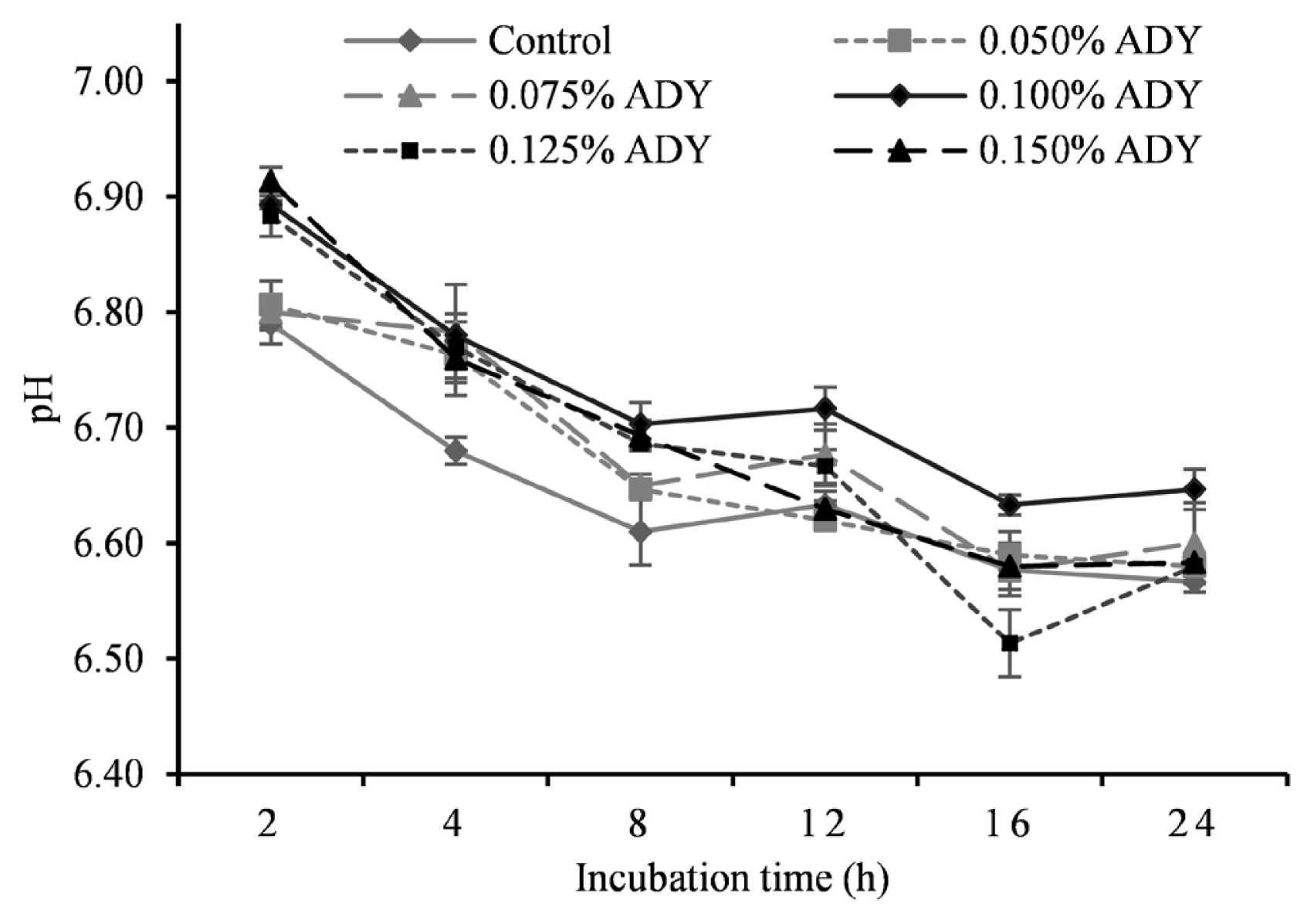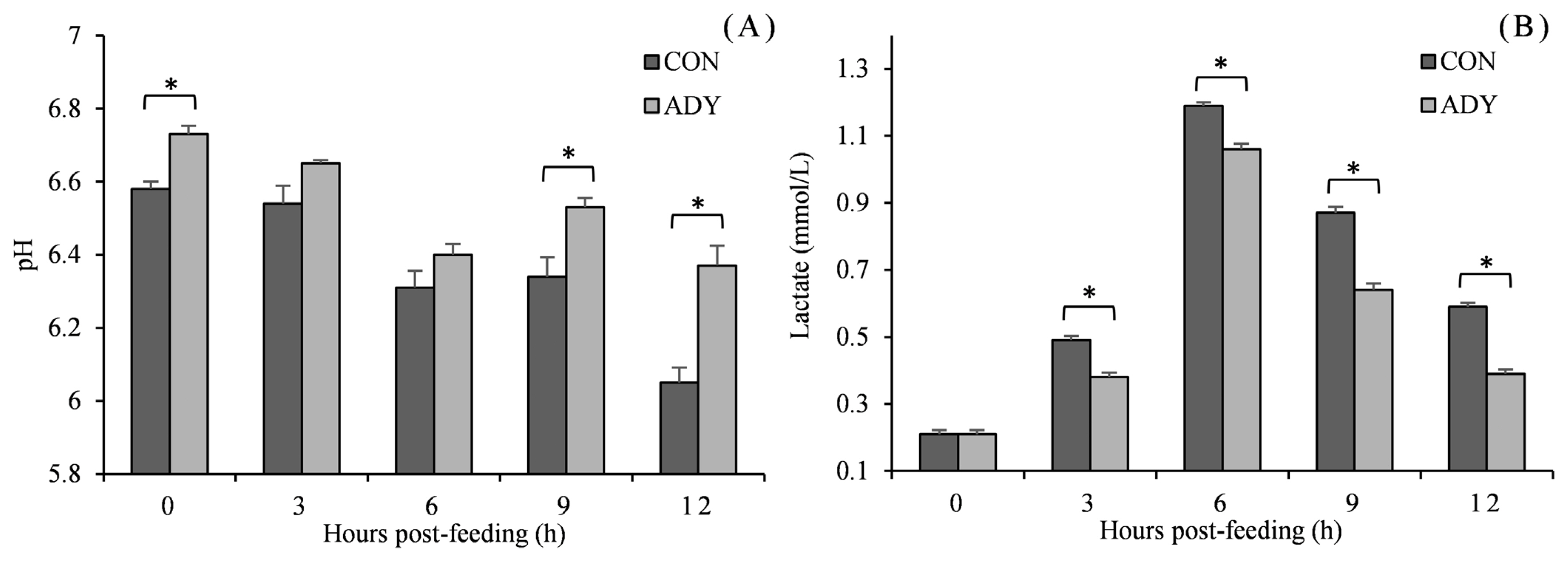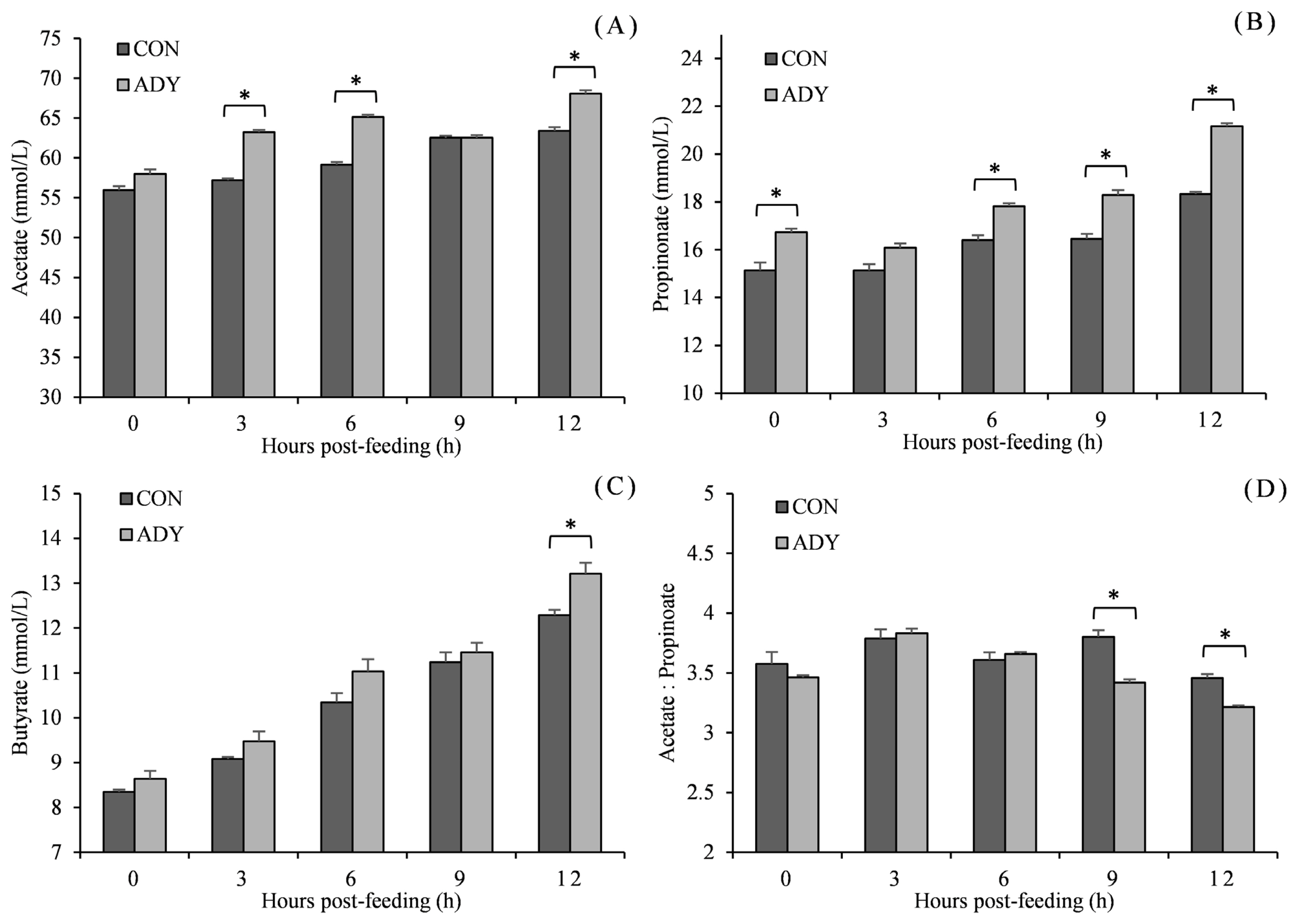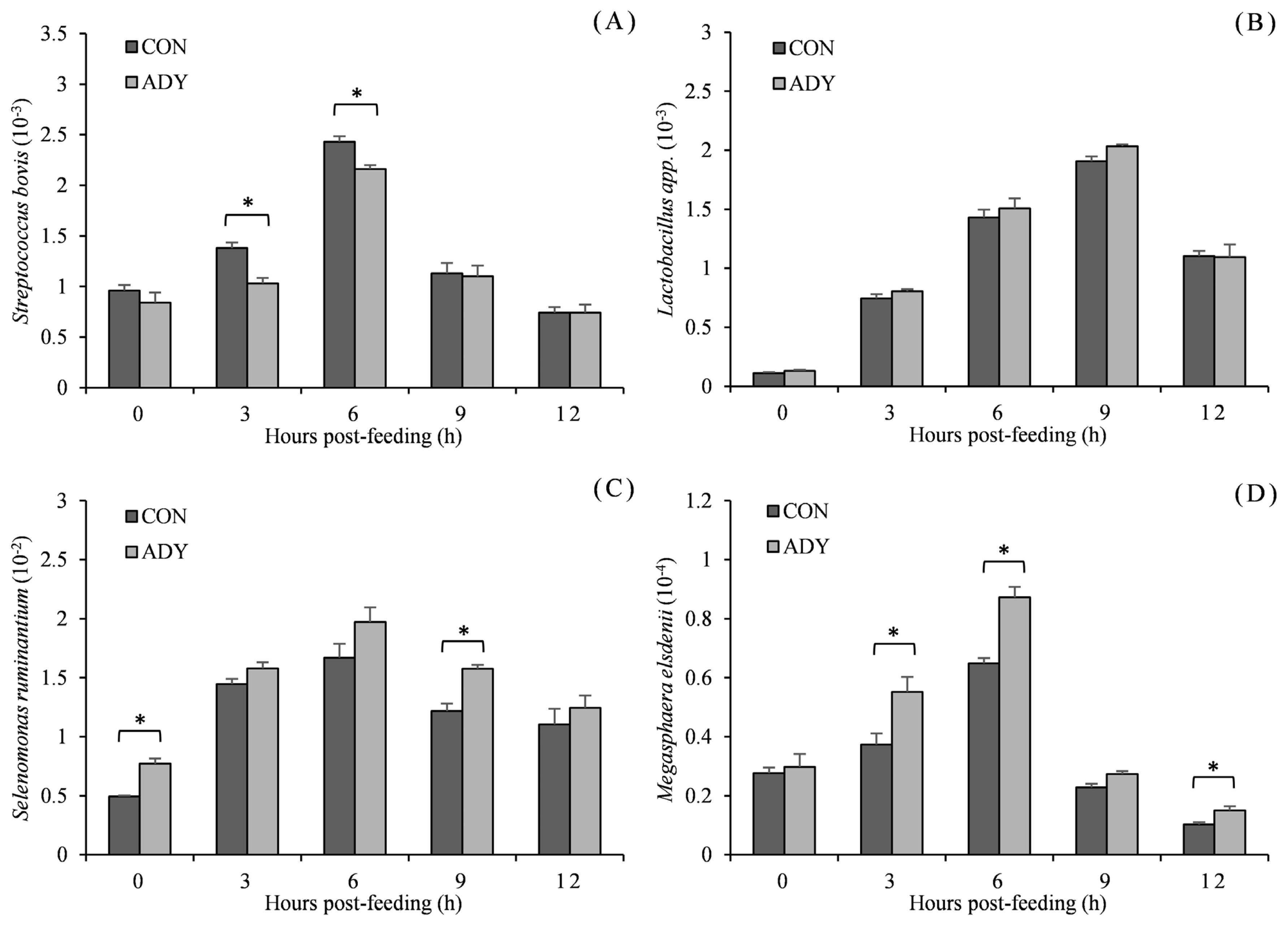1. Hobson PN, Stewart CS. The rumen microbial ecosystem. London, UK: Blackie Academic & Professional; 1997.
2. Moallem U, Lehrer H, Livshitz L, Zachut M, Yakoby S. The effects of live yeast supplementation to dairy cows during the hot season on production, feed efficiency, and digestibility. J Dairy Sci 2009; 92:343ŌĆō51.
https://doi.org/10.3168/jds.2007-0839


3. Jiao P, He Z, Ding S, et al. Impact of strain and dose of live yeast and yeast derivatives on in vitro ruminal fermentation of a high-grain diet at two pH levels. Can J Anim Sci 2018; 98:477ŌĆō87.
https://doi.org/10.1139/cjas-2017-0079

4. Rossi F, Luccia AD, Vincenti D, Cocconcelli PS. Effects of peptidic fractions from Saccharomyces cerevisiae culture on growth and metabolism of the ruminal bacteria Megasphaera elsdenii. Anim Res 2004; 53:177ŌĆō86.
https://doi.org/10.1051/animres:2004009

7. Zhang X, Zhang H, Wang Z, et al. Effects of dietary carbohydrate composition on rumen fermentation characteristics and microbial population in vitro. Ital J Anim Sci 2015; 14:3366
https://doi.org/10.4081/ijas.2015.3366

8. Plaizier JC, Krause DO, Gozho GN, McBride BW. Subacute ruminal acidosis in dairy cows: the physiological causes, incidence and consequences. Vet J 2008; 176:21ŌĆō31.
https://doi.org/10.1016/j.tvjl.2007.12.016


9. Wanapat M, Gunun P, Anantasook N, Kang S. Changes of rumen pH, fermentation and microbial population as influenced by different ratios of roughage (rice straw) to concentrate in dairy steers. J Agric Sci 2014; 152:675ŌĆō85.
https://doi.org/10.1017/S0021859613000658

11. Nagaraja TG, Titgemeyer EC. Ruminal acidosis in beef cattle: the current microbiological and nutritional outlook. J Dairy Sci 2007; 90:E17ŌĆōE38.
https://doi.org/10.3168/jds.2006-478


12. Penner GB. Short chain fatty acid absorption and regulation of ruminal pH. In : Florida Ruminant Nutrition Conference 2019; Gainesville, FL, USA: University of Florida; 2019.
13. Luo J, Ranadheera CS, King S, Evans C, Baines S. In vitro investigation of the effect of dairy propionibacteria on rumen pH, lactic acid and volatile fatty acids. J Integr Agric 2017; 16:1566ŌĆō75.
https://doi.org/10.1016/S2095-3119(16)61556-3

14. Cagle CM, Tedeschi LO, Runyan CA, Callaway TR, Cravey MD. Evaluation of the effects of dried live yeast on rumen pH and in situ digestibility of dry matter in growing cattle. J Anim Sci 2018; 96:62ŌĆō3.
https://doi.org/10.1093/jas/sky027.117

15. Stella AV, Paratte R, Valnegri L, et al. Effect of administration of live Saccharomyces cerevisiae on milk production, milk composition, blood metabolites, and faecal flora in early lactating dairy goats. Small Rumin Res 2007; 67:7ŌĆō13.
https://doi.org/10.1016/j.smallrumres.2005.08.024

16. Magrin L, Gottardo F, Fiore E, et al. Use of a live yeast strain of Saccharomyces cerevisiae in a high-concentrate diet fed to finishing Charolais bulls: effects on growth, slaughter performance, behavior, and rumen environment. Anim Feed Sci Technol 2018; 241:84ŌĆō93.
https://doi.org/10.1016/j.anifeedsci.2018.04.021

17. Sousa DO, Oliveira CA, Velasquez AV, et al. Live yeast supplementation improves rumen fibre degradation in cattle grazing tropical pastures throughout the year. Anim Feed Sci Technol 2018; 236:149ŌĆō58.
https://doi.org/10.1016/j.anifeedsci.2017.12.015

18. Menke K, Raab L, Salewski A, Steingass H, Fritz D, Schneider W. The estimation of the digestibility and metabolizable energy content of ruminant feedingstuffs from the gas production when they are incubated with rumen liquor in vitro. J Agric Sci 1979; 93:217ŌĆō22.
https://doi.org/10.1017/S0021859600086305

20. Opsi F, Fortina R, Tassone S, Bodas R, L├ōPez S. Effects of inactivated and live cells of Saccharomyces cerevisiae on in vitro ruminal fermentation of diets with different forage: concentrate ratio. J Agric Sci 2012; 150:271ŌĆō83.
https://doi.org/10.1017/s0021859611000578

21. Besharati M. Effect of Saccharomyces cerevisiae supplementation on in vitro gas production of biscuit waste. Glob J Anim Sci Res 2015; 3:512ŌĆō7.
22. Tristant D, Moran C. The efficacy of feeding a live probiotic yeast, Yea-Sacc®, on the performance of lactating dairy cows. J Appl Anim Nutr 2015; 3:e12
https://doi.org/10.1017/jan.2015.10

23. Cagle CM, Fonseca MA, Callaway TR, Runyan CA, Cravey MD, Tedeschi LO. Evaluation of the effects of live yeast on rumen parameters and in situ digestibility of dry matter and neutral detergent fiber in beef cattle fed growing and finishing diets. Appl Anim Sci 2020; 36:36ŌĆō47.
https://doi.org/10.15232/aas.2019-01888

25. Thrune M, Bach A, Ruiz-Moreno M, Stern MD, Linn JG. Effects of Saccharomyces cerevisiae on ruminal pH and microbial fermentation in dairy cows: Yeast supplementation on rumen fermentation. Livest Sci 2009; 124:261ŌĆō5.
https://doi.org/10.1016/j.livsci.2009.02.007

26. Tripathi MK, Karim SA. Effect of individual and mixed live yeast culture feeding on growth performance, nutrient utilization and microbial crude protein synthesis in lambs. Anim Feed Sci Technol 2010; 155:163ŌĆō71.
https://doi.org/10.1016/j.anifeedsci.2009.11.007

27. Chaucheyras-Durand F, Masseglia S, Fonty G. Effect of the microbial feed additive Saccharomyces cerevisiae CNCM I-1077 on protein and peptide degrading activities of rumen bacteria grown in vitro. Curr Microbiol 2005; 50:96ŌĆō101.
https://doi.org/10.1007/s00284-004-4433-1


28. Marden JP, Julien C, Monteils V, Auclair E, Moncoulon R, Bayourthe C. How does live yeast differ from sodium bicarbonate to stabilize ruminal pH in high-yielding dairy cows? J Dairy Sci 2008; 91:3528ŌĆō35.
https://doi.org/10.3168/jds.2007-0889


29. Geng CY, Ren LP, Zhou ZM, Chang Y, Meng QX. Comparison of active dry yeast (Saccharomyces cerevisiae) and yeast culture for growth performance, carcass traits, meat quality and blood indexes in finishing bulls. Anim Sci J 2016; 87:982ŌĆō8.
https://doi.org/10.1111/asj.12522


31. Mao H, Mao H, Wang JK, Liu JX, Yoon I. Effects of Saccharomyces cerevisiae fermentation product on in vitro fermentation and microbial communities of low-quality forages and mixed diets. J Anim Sci 2013; 91:3291ŌĆō8.
https://doi.org/10.2527/jas.2012-5851


32. Newbold CJ, Wallace R, McIntosh F. Mode of action of the yeast Saccharomyces cerevisiae as a feed additive for ruminants. Br J Nutr 1996; 76:249ŌĆō61.
https://doi.org/10.1079/BJN19960029


33. Oeztuerk H, Schroeder B, Beyerbach M, Breves G. Influence of living and autoclaved yeasts of Saccharomyces boulardii on in vitro ruminal microbial metabolism. J Dairy Sci 2005; 88:2594ŌĆō600.
https://doi.org/10.3168/jds.S0022-0302(05)72935-0


34. Sato S. Pathophysiological evaluation of subacute ruminal acidosis (SARA) by continuous ruminal pH monitoring. Anim Sci J 2016; 87:168ŌĆō77.
https://doi.org/10.1111/asj.12415


37. Enemark JMD, Jorgensen R, Enemark PS. Rumen acidosis with special emphasis on diagnostic aspects of subclinical rumen acidosis: a review. Veterinarija ir zootechnika 2002; 20:16ŌĆō29.
38. Petri RM, Forster RJ, Yang W, McKinnon JJ, McAllister TA. Characterization of rumen bacterial diversity and fermentation parameters in concentrate fed cattle with and without forage. J Appl Microbiol 2012; 112:1152ŌĆō62.
https://doi.org/10.1111/j.1365-2672.2012.05295.x


40. Malekkhahi M, Tahmasbi AM, Naserian AA, et al. Effects of supplementation of active dried yeast and malate during sub-acute ruminal acidosis on rumen fermentation, microbial population, selected blood metabolites, and milk production in dairy cows. Anim Feed Sci Technol 2016; 213:29ŌĆō43.
https://doi.org/10.1016/j.anifeedsci.2015.12.018

42. Belanche A, Doreau M, Edwards JE, Moorby JM, Pinloche E, Newbold CJ. Shifts in the rumen microbiota due to the type of carbohydrate and level of protein ingested by dairy cattle are associated with changes in rumen fermentation. J Nutr 2012; 142:1684ŌĆō92.
https://doi.org/10.3945/jn.112.159574


43. Silberberg M, Chaucheyras-Durand F, Commun L, et al. Repeated acidosis challenges and live yeast supplementation shape rumen microbiota and fermentations and modulate inflammatory status in sheep. Animal 2013; 7:1910ŌĆō20.
https://doi.org/10.1017/S1751731113001705


44. Mickdam E, Khiaosa-ard R, Metzler-Zebeli BU, Klevenhusen F, Chizzola R, Zebeli Q. Rumen microbial abundance and fermentation profile during severe subacute ruminal acidosis and its modulation by plant derived alkaloids in vitro. Anaerobe 2016; 39:4ŌĆō13.
https://doi.org/10.1016/j.anaerobe.2016.02.002


45. Wang H, Pan X, Wang C, Wang M, Yu L. Effects of different dietary concentrate to forage ratio and thiamine supplementation on the rumen fermentation and ruminal bacterial community in dairy cows. Anim Prod Sci 2015; 55:189ŌĆō93.
https://doi.org/10.1071/AN14523

47. Chaucheyras F, Fonty G, Gouet P, Bertin G, Salmon J-M. Effects of a strain of Saccharomyces cerevisiae (Levucell┬« SC), a microbial additive for ruminants, on lactate metabolism in vitro. Can J Microbiol 1996; 42:927ŌĆō33.
https://doi.org/10.1139/m96-119


49. Yalcin S, Yalcin S, Can P, G├╝rdal AO, Bagci C, Eltan O. The nutritive value of live yeast culture (Saccharomyces cerevisiae) and its effect on milk yield, milk composition and some blood parameters of dairy cows. Asian-Australas J Anim Sci 2011; 24:1377ŌĆō85.
https://doi.org/10.5713/ajas.2011.11060

50. Kowalik B, Skomial J, Pajak JJ, et al. Population of ciliates, rumen fermentation indicators and biochemical parameters of blood serum in heifers fed diets supplemented with yeast (Saccharomyces cerevisiae) preparation. Anim Sci Pap Rep 2012; 30:329ŌĆō38.
51. Hassan A, Salem A, Kholif A, et al. Performance of crossbred dairy Friesian calves fed two levels of Saccharomyces cerevisiae: intake, digestion, ruminal fermentation, blood parameters and faecal pathogenic bacteria. J Agric Sci 2016; 154:1488ŌĆō98.
https://doi.org/10.1017/S0021859616000599

52. Dole┼Šal P, Dvo┼Ö├Ī─Źek J, Dole┼Šal J, et al. Effect of feeding yeast culture on ruminal fermentation and blood indicators of Holstein dairy cows. Acta Vet Brno 2011; 80:139ŌĆō45.
https://doi.org/10.2754/avb201180020139

54. Denman SE, McSweeney CS. Development of a real-time PCR assay for monitoring anaerobic fungal and cellulolytic bacterial populations within the rumen. FEMS Microbiol Ecol 2006; 58:572ŌĆō82.
https://doi.org/10.1111/j.1574-6941.2006.00190.x


55. Stevenson DM, Weimer PJ. Dominance of Prevotella and low abundance of classical ruminal bacterial species in the bovine rumen revealed by relative quantification real-time PCR. Appl Microbiol Biotechnol 2007; 75:165ŌĆō74.
https://doi.org/10.1007/s00253-006-0802-y


58. Qi H, Xiang Z, Han G, Yu B, Huang Z, Chen D. Effects of different dietary protein sources on cecal microflora in rats. Afr J Biotechnol 2011; 10:3704ŌĆō8.
https://doi.org/10.5897/AJB10.2677

59. Vitti A, La Monaca E, Sofo A, et al. Beneficial effects of Trichodermaharzianum T-22 in tomato seedlings infected by Cucumber mosaic virus (CMV). BioControl 2015; 60:135ŌĆō47.
https://doi.org/10.1007/s10526-014-9626-3











 PDF Links
PDF Links PubReader
PubReader ePub Link
ePub Link Full text via DOI
Full text via DOI Download Citation
Download Citation Print
Print







